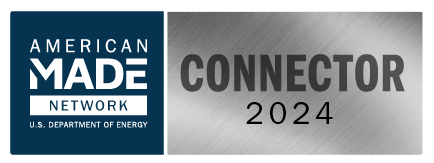Photo courtesy of FuzeHub
The week of Oct. 15, 2023, was a significant one for Koffman member company Ashlawn Energy and its President and Founder, Norma Byron.
It all started in Saratoga Springs, NY from Oct. 15 to 17 at the New York State Innovation Summit. The annual event, hosted by FuzeHub and supported by Empire State Development’s Division of Science, Technology and Innovation (NYSTAR), features a Commercialization Competition giving companies across the state a chance to compete for funding. Competition finalists are invited to attend the Summit and pitch their technology or product to a panel of judges tasked with awarding a total of $450,000 to the seven best projects.
Not only was Ashlawn Energy a repeat finalist invited to the Summit this year, but the company went on to win the 2023 Commercialization Competition grand prize of $150,000.
“First, I just was overcome by emotion” Byron recalled of the moment when Ashlawn was announced as the grand prize recipient, “and then I was absolutely delighted because we had some pretty stiff competition there. There are a lot of people with good technologies, and actually, I felt like I became friends with several of them. I think we were all kind of rooting for each other [and] it wasn’t one of these cutthroat competitions, it was kind of a nice competition. We were there to support each other and I really liked that.”
For the competition, Byron presented the technology behind Ashlawn Energy and the safety benefits of implementation.
Ashlawn Energy is focused on battery energy storage. Instead of innovating the widely popular lithium-ion battery, Ashlawn instead focuses on vanadium flow batteries and introducing that technology into wider, large-scale use.
“It’s more like hydrogen fuel cell technology but instead of hydrogen, we use a liquid electrolyte,” Byron explained of the chemistry behind vanadium flow batteries. “Instead of flowing gaseous hydrogen, we flow a liquid electrolyte through our battery system, and it’s really good for storing power.”
The other benefit of using electrolytes within battery energy storage is their longevity. While lithium-ion batteries can last between five to seven years, a vanadium flow battery can last beyond 30 years simply because of the lifespan of the electrolyte within the vanadium mixture.
Instead of focusing their efforts on EVs or handheld technology, Ashlawn’s target market is buildings — specifically multi-family or commercial office buildings in New York City. Their VanCharg™ battery stores power at off-peak times and uses power during on-peak times, with the additional capability of being connected to microgrids.
“The idea is that if we can reduce electrical demand at the building level, then the utility does not need to spend billions of dollars putting in expensive substations or billions of dollars building more power plants and things like that,” Bryon explained. “So it not only saves money, but it also reduces greenhouse gas emissions because when the power plants operate at below peak capacity, they emit a lot less pollution than when they run at peak capacity or near peak. It’s better to be able to charge at nighttime or during off-peak times.”
For Ashlawn, the journey to realizing their target market and expansion of product capability was a direct result of working with the Koffman and their subsequent participation in an I-Corps regional course.
“The Koffman has been great,” Byron said. “They encouraged me to go through National Science Foundation (NSF) I-Corps training… I did the regional training and then they sponsored me to go do the national training. That really helped to focus me on the customer discovery side to figure out what market [to target], because before that I was saying, ‘Oh, we could do this, we could do that, we could pursue all these different markets’. Sure, the technology will allow it, but I think that if you try to concentrate on everything, pretty soon you concentrate on nothing.”
NSF I-Corps programming helps companies through a focused customer discovery process. Throughout their course, participants will be tasked with not only narrowing down their target market but also performing interviews with stakeholders in the market they’ve identified. I-Corps courses are offered throughout the year in both hybrid and virtual settings.
Beyond her appreciation for Koffman’s encouragement surrounding I-Corps participation, Bryon is also grateful for other help staff has provided.
“Another piece was Koffman connected us with interns through the Student Startup Experience and that has been great. The coaching that I’ve gotten from Mike Jagelski has been fantastic…I think with New Energy New York, the level of support has increased — so we’re really excited about that. Through time [it] has been a good relationship, just all in all.”
“Norma and the Incubator go back a number of years,” Director of the Koffman’s Clean Energy Incubator Program Mike Jagielski stated. “Over that time, Norma has made wonderful progress from concept, to prototype to now scale up. The FuzeHub grand prize award is a testament to her tenacity and business drive to make her vision a commercial success. In my humble opinion, the key turnaround to Norma’s success has been her participation in the NSF Regional I-Corps program as well as the fantastic interns she received through the NENY Student Startup Experience. This changed her way of thinking about go-to-market strategies and manufacturing processes required to get her to the next level of commercialization. Now, after the win at FuzeHub, venture capital is starting to flow in and it is just a matter of time before Ashlawn Energy will have a number of demonstration projects throughout New York state in the battery and energy storage space.”
Shortly after the Commercialization Competition victory was announced, Byron drove two and a half hours south from Saratoga Springs back to Binghamton. That evening of Oct. 17 was the Welcome Reception for Binghamton’s first-ever Battery Week at the Koffman. Ten companies were invited to exhibit at the reception for the chance to be in a mini-pitch competition. Bryon would again, just hours after winning a competition, be pitching Ashlawn Energy for the chance to win additional funding. The first-place company would receive $5,000 and two runners-up would each receive $1,000.
“It was friendly,” Bryon said, “I saw a lot of people I knew and that was handy. But I also got to know people and got to meet a lot of people that I didn’t know. I did have some potential vendors that contacted me, which I’m now following up with. So it was a great networking experience and I just really enjoyed that and meeting a lot of the other people.”
After pitching as one of the final three, Ashlawn was awarded as a runner-up. With the total competition awards won over the week, Byron said Ashlawn would use the funding to help them automate their battery stack assembly which is currently done by hand. Not only will this save time and allow for more output, but it also lessens the possibility for errors and variation between the stacks.
Ashlawn intends for this next phase of the company and their journey into automation to occur at their space in the Koffman. This is a step which wouldn’t be possible without taking the leap into competitions and pitching.
“With FuzeHub, I had several investors contact me and now all of a sudden, we’re negotiating major investments in Ashlawn Energy. So the visibility that you get from doing [competitions] is really, really important,” Byron explained. “At the Koffman event, it was more about finding out what vendors were there and who could help me. I guess you boil it down to visibility, you know, from press, from vendors to potential investors. I just really think participating is good from all those perspectives.”



